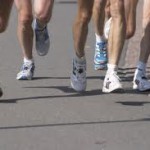Time is a Hunter
SOME PEOPLE, after hearing about Olga for the first time, go to YouTube clips expecting to see her tearing down the track like Flo-Jo. She doesn’t.
Let’s put this in perspective: Olga is one of the fastest 94-year-olds who ever lived. But she is 94 — and there are certain things that happen to the human body that are simply inevitable and non-negotiable. Time is an unforgiving hunter. Beyond age 75 or so, the performance curves crater for everybody, no exceptions. Age steals away fast-twitch muscle, and then it steals away slow-twitch muscle. It changes the way we look when we move. The process usually happens too gradually to see — unless a vivid demonstration like this one is cooked up.
On the last day of the world outdoor masters athletics championships in Lahti in 2010, organizers staged a crowd-pleasing contest called a “unique handicap race.” All of world-record setters in the 100-metre dash gathered on the track. Six women lined up, youngest (35) to oldest (90). The youngest, Czech Stepanka Gottvaldova, began at the starting line and everyone else was given a progressively bigger head start. Olga’s starting block was a good thirty metres downfield.
Here’s what happens:
At the snap of the gun. Olga is off. But she’s soon caught by New Zealander Margaret Peters, 75. Then the rest of the field reels her in. The 50, 70, 60, and then 80-year-old champions overtake her. By the 80-metre mark Olga is dead last. If you keep pushing the pause button on the video, reducing the race to a set of stills, the sense is overwhelmingly of a kind of time-lapse depiction of the aging process. In the older runners the stride length shortens, the posture changes. It looks like those hominid-from-ape evolutionary charts, but in reverse.
To me, a few things jump out from those results. (Apart from the fact that the race wasn’t quite handicapped properly. If it were, all the runners would have finished in roughly the same time.)
The big difference between the runners is not the turnover rate, the actual number of steps each athlete is taking; the difference is power. The dropoff in muscular force isn’t something you necessary notice in the longer distances, but it’s obvious in the sprints. The sheer electric force of the younger runners is just not there in the older ones. It has to do with the rapid loss of muscle mass beyond age 75 or so, and other factors, such as the loss in number and quality of mitochondria in that muscle. Scientists such as Tanja Taivassalo and Russ Hepple are investigating what else might be involved, and why certain people (like Olga) seem naturally better protected from the ravages of time than others.
But to me, that clip evokes something much bigger than sport. It strikes me as a metaphor for what aging must feel like, in those upper registers. The old are getting reeled in by the young. They are simply getting overtaken by the trappings of youth culture – the pace of media, technology, data movement, processing speed; the primacy of sex appeal and immediately gratified appetites. You have to be a pretty strong person, comfortable in your own skin, to stay in the race under those conditions. To keep pressing, without letting up in discouragement, right to the tape.
